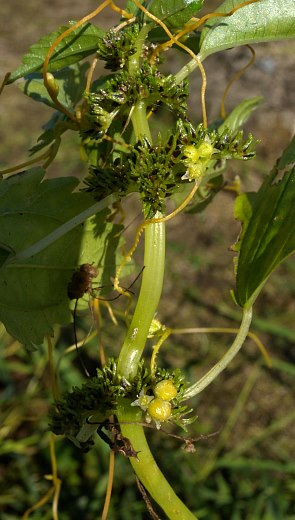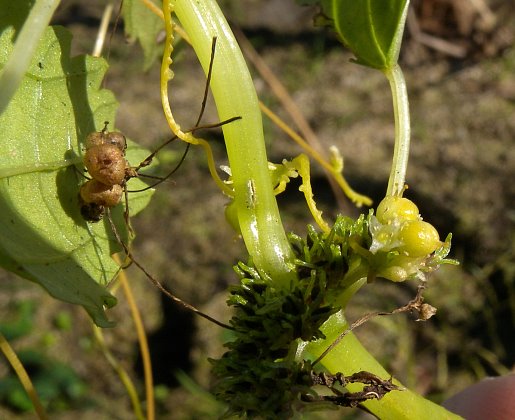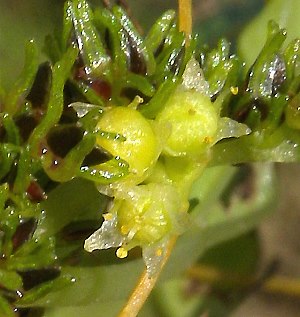 Description:
This herbaceous parasitic vine is a summer annual that is several feet
along. It clings to adjacent vegetation using suckers (haustoria) on
its stems. Lacking chlorophyll and a significant root system, this vine
is dependent on its host plants for water and nutrients. The stems are
usually pale yellow, sometimes becoming pale orange with age; they are
glabrous and terete. Alternate leaves along the stems are reduced to
tiny scales, or they are absent altogether. Small clusters of nearly
sessile flowers occur at intervals along the stems. The peduncles and
pedicels of these flowers are pale yellow to pale orange and glabrous.
Each flower spans about 3 mm. (1/8" across), consisting of a white
corolla with 4 lobes, a light green calyx with 4 lobes, 4
stamens, and an ovary with a pair of divergent styles. Less often, a
flower may have a corolla with 5 lobes, a calyx with 5 lobes, and 5
stamens. The lobes of the corolla are deltate-ovate in shape and
ascending to widely spreading. The calyx is glabrous with rounded
lobes; it is shorter than the corolla. Both the corolla and calyx are
short-tubular and bell-shaped (campanulate). At the base of the stamens
within the corolla, are fringed scales that require at least a 10x
hand lens to see. There are no floral bracts
underneath the flowers. The blooming period occurs from mid-summer to
early fall, lasting about 1½ months. There may be a mild floral
fragrance. In the absence of insect pollinators, the flowers are
self-fertile; they are replaced by globoid seed capsules spanning 3-5
mm. across. The glabrous seed capsules are surrounded by the withered
remains of their corollas; they are initially light green, but turn
brown at maturity. Each capsule is 2-celled, and each cell contains 2
seeds. The capsules eventually split open to release their seeds. The
seeds are about 1.5 mm. long (or slightly more), ovoid in shape, and
slightly compressed. There is a rudimentary root system at the seedling
stage, but this is abandoned shortly after a suitable host plant has
been found. If no host plant is found, the seedling dies within a few
days.
Description:
This herbaceous parasitic vine is a summer annual that is several feet
along. It clings to adjacent vegetation using suckers (haustoria) on
its stems. Lacking chlorophyll and a significant root system, this vine
is dependent on its host plants for water and nutrients. The stems are
usually pale yellow, sometimes becoming pale orange with age; they are
glabrous and terete. Alternate leaves along the stems are reduced to
tiny scales, or they are absent altogether. Small clusters of nearly
sessile flowers occur at intervals along the stems. The peduncles and
pedicels of these flowers are pale yellow to pale orange and glabrous.
Each flower spans about 3 mm. (1/8" across), consisting of a white
corolla with 4 lobes, a light green calyx with 4 lobes, 4
stamens, and an ovary with a pair of divergent styles. Less often, a
flower may have a corolla with 5 lobes, a calyx with 5 lobes, and 5
stamens. The lobes of the corolla are deltate-ovate in shape and
ascending to widely spreading. The calyx is glabrous with rounded
lobes; it is shorter than the corolla. Both the corolla and calyx are
short-tubular and bell-shaped (campanulate). At the base of the stamens
within the corolla, are fringed scales that require at least a 10x
hand lens to see. There are no floral bracts
underneath the flowers. The blooming period occurs from mid-summer to
early fall, lasting about 1½ months. There may be a mild floral
fragrance. In the absence of insect pollinators, the flowers are
self-fertile; they are replaced by globoid seed capsules spanning 3-5
mm. across. The glabrous seed capsules are surrounded by the withered
remains of their corollas; they are initially light green, but turn
brown at maturity. Each capsule is 2-celled, and each cell contains 2
seeds. The capsules eventually split open to release their seeds. The
seeds are about 1.5 mm. long (or slightly more), ovoid in shape, and
slightly compressed. There is a rudimentary root system at the seedling
stage, but this is abandoned shortly after a suitable host plant has
been found. If no host plant is found, the seedling dies within a few
days.Cultivation: This vine is typically found in wet to moist areas that are exposed to sun or partial sun. It cannot survive without a suitable host plant, although apparently many species of moisture-loving plants and shrubs can serve this purpose. Examples of suitable host plants include buttonbush (Cephalanthus occidentalis), water willow (Justicia americana), false nettle (Boehmeria cylindrica), asters (Aster spp.), goldenrods (Solidago spp.), bugleweed (Lycopus spp.), and even horsetails (Equisetum spp.). Soil type depends on the preferences of host plants, but can consist of sand, silt, loam, or muck. This vine can significantly weaken any host plant that it comes in contact with.

Range & Habitat: The native Buttonbush Dodder is scattered throughout Illinois, where it is uncommon to occasional (see Distribution Map). Habitats include floodplain woodlands, swamps, soggy thickets along rivers, marshes, and wet prairies. This vine occurs in both sandy and non-sandy wetlands.
Faunal Associations: Robertson (1929) observed a small Halictid bee, Lasioglossum coriaceus, sucking nectar from the flowers of Buttonbush Dodder. Other small bees also visit the flowers for nectar, and possibly some moths (Müller, 1873/1883). According to Georgia (1913), the seeds of dodders can pass through the digestive tracts of grazing animals (e.g., cattle & horses) and remain viable. Thus, these animals may help to distribute these vines into new areas.

Photographic Location: A sandy marsh at the Heron Boardwalk in Vermilion County, Illinois.
Comments: Buttonbush Dodder has a fairly typical appearance for the parasitic vines of this genus, although it is somewhat unusual in having 4-parted flowers (4-lobed corollas, 4-lobed calyces, and 4 stamens), rather than 5-parted flowers (5-lobed corollas, 5-lobed calyces, 5 stamens). Unlike other dodder species (Cuscuta spp.) with 4-parted flowers, the corolla lobes of Buttonbush Dodder usually spread outward rather than remain erect. Thus, it is a fairly easy species to identify during the blooming period. Some taxonomists have placed dodder species in the Morning Glory family (Convolvulaceae).